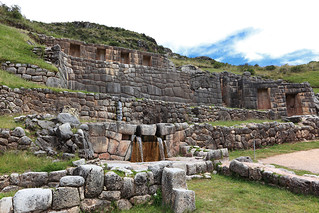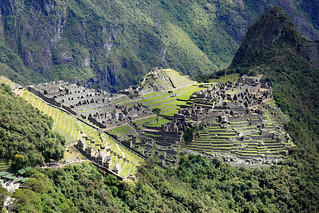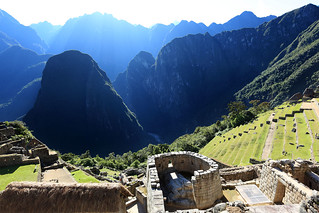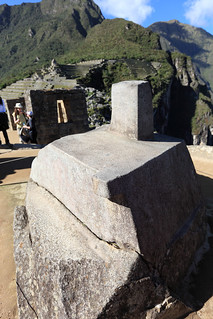

| Archive Blog Cast Forum RSS Books! Poll Results About Search Fan Art Podcast More Stuff Random |
|
Classic comic reruns every day
|
1 {photo of Machu Picchu}
1 Caption: City in the Clouds
|
First (1) | Previous (3270) | Next (3272) || Latest Rerun (2873) |
Latest New (5380) First 5 | Previous 5 | Next 5 | Latest 5 Annotations theme: First | Previous | Next | Latest || First 5 | Previous 5 | Next 5 | Latest 5 This strip's permanent URL: http://www.irregularwebcomic.net/3271.html
Annotations off: turn on
Annotations on: turn off
|
 Tambomachay. |
The Inca rulers had already built a small mountain retreat not far from Cusco, in the hills overlooking the city from the north. The site was known as Tambomachay and it had terraces and cunningly crafted fountains channeling the mountain spring water and some modest dwellings. Down the road towards Cusco a bit was the fortress of Pukapukara. This had a direct line of sight to Tambomachay along the valley, allowing signalling between them. Pukapukara was manned by soldiers as a guard post for the only access route to Tambomachay.
Although guarded, Tambomachay was easy to find. If an invading force took Cusco, they could easily locate and lay siege to Tambomachay, just a couple of hours walk along the road that passed the temple complex of Sacsayhuamán. The Inca decided to build something more easily defensible, more remote, more hidden, and much, much grander.
The plateau north of the valley of Cusco rises to an altitude of 3800 metres. Beyond it are the formidable snow-bound peaks of the northern chain of the Andes. Travelling across this plateau, one gets the feeling that any further progress will be hopeless, akin to trying to cross the Misty Mountains of Middle-earth. But just before the mountains, the plateau drops away, plunging into the valley of the Urubamba River. The Inca referred to this as the Sacred Valley. Its narrow plains supported agriculture of corn and quinoa and potatoes, making it a place of abundance. They built towns along the river, terraced its banks to provide more flat land to cultivate, and constructed numerous granaries and temples out of the hard Andean stone.
 Urubamba River and the Sacred Valley of the Inca. |
But if you press on regardless for many kilometres, you eventually reach a sharp bend in the river, where a stream formed by a natural hot spring joins it, and here there is enough flat space to stop and rest a while.
The mountains around here look utterly impassable, rising sheer from the raging river, slick with moisture and jungle. You would never suspect that anything lurked above. Yet over your head, invisible from the river, a narrow path has been cut into the rock. It skirts around the highest peaks, climbs precipitous stairs up and over narrow passes, hanging between the sheer rock on one side and the open sky on the other. And just above this bend in the Urubamba River, this Inca trail crests a high pass and looks down upon a most marvellous sight.
It is the city that the Inca built as a remote retreat for the nobility. It lies on a narrow saddle of land perched between cliffs falling away to the Urubamba River on the east and west, the sugarloaf peak of Huayna Picchu to the south, and the imposing mountain on the north side that gives the city its name: Machu Picchu.
 Machu Picchu from the Sun Gate at the end of the Inca Trail. |
The Inca were still in the process of building this city when an event occurred that would change the course of their civilisation. The Spanish Conquistadors arrived in South America. They encountered the Inca Empire and systematically tore it apart with the help of their horses, guns, and armour. The Inca were horrified when the Conquistadors laid waste to their cities and desecrated their holy sites. Some of the Inca in the Cusco area retreated into the mountains. But rather than hole up in their incomplete fortress and await destruction, they abandoned Machu Picchu. They effectively erased it from their history so that the Conquistadors could not find it and destroy it.
And so for 340 years Machu Picchu remained hidden. The jungle reclaimed the saddle of land between Huayna Picchu and Machu Picchu mountain. Until 1911, when Hiram Bingham of Yale University followed the hints and reports of local farmers in the area who were eager to lead him to hidden Inca ruins for the promise of monetary rewards. A farmer named Melchor Arteaga, working hard at coaxing crops out of this remote corner of the Peruvian jungle, led Bingham up a difficult and hazardous path from the Urubamba River to the overgrown remains of Machu Picchu.
 Temple of the Sun and the Andes. |
Bingham returned to Machu Picchu on further expeditions up to 1915, excavating and uncovering the stonework from the jungle. He wrote several books about his discoveries and his extrapolations about the history and culture of Machu Picchu and the Inca. Much of his speculation has since been superseded with more accurate archaeological and historical evidence about the role of Machu Picchu in the Inca Empire. The books however still contain fantastic passages describing Bingham's own adventures in a slightly larger-than-life narrative that emphasises the wonder of the strange terrain and the dangers faced in exploring the jungle. Bingham's tales of archaeological derring-do informed the modern archetype of the adventurer archaeologist and, whether consciously or not, the creation of Indiana Jones.
Machu Picchu now is a World Heritage Site and the most popular tourist destination in South America. It still takes some travelling to get to, but has been made easier by the running of a narrow gauge single track train line across the plateau from Cusco to Ollantaytambo and then along the Urubamba River to Aguas Calientes, the town that has grown up on the small patch of land near the hot springs below Machu Picchu. Alternatively, tourists can hike the Inca Trail, taking several days to walk the path from the upper Urubamba River region into the depths of the mountains to emerge at the Sun Gate overlooking Machu Picchu.
 Intihuatana in the Machu Picchu observatory. |
At the highest point within the city (but below the guard posts and Sun Gate) is the observatory, placed on a natural pyramid of rock. At its peak is a bare outcrop of angular rock shaped into a roughly square point. This is the Intihuatana, which the Inca associated with the sun and ritually believed was important in ensuring the sun would return to the sky each day and to regulate the cycle of the seasons. Various alignments of the stone with niches in surrounding walls mark the passage of the seasons.
Standing here, in the middle of the last refuge of the Inca, you can look down to the Urubamba River in the shadowed valleys far below, down to the terraces that spill down the steep valley walls, down to the houses and temples where the Inca lived and went about their business, up to the steps leading up to the city entrance and guard posts, up to the Sun Gate cresting a pass on the flanks of Machu Picchu Mountain, up to the nearby jungle-choked peaks of Huayna Picchu and Machu Picchu, and beyond to the snow-capped spires of the Andes in all directions. The sun, so important to the Inca, filters through it all, throwing the sharp relief of the landscape into contrasting areas of light and shadow. Vegetation never looks so green, the sky never looks so blue. And you imagine what it must have been like living here. It may have been selected for isolation and defensibility, but it's a beautiful view.
|
LEGO® is a registered trademark of the LEGO Group of companies,
which does not sponsor, authorise, or endorse this site. This material is presented in accordance with the LEGO® Fair Play Guidelines. |